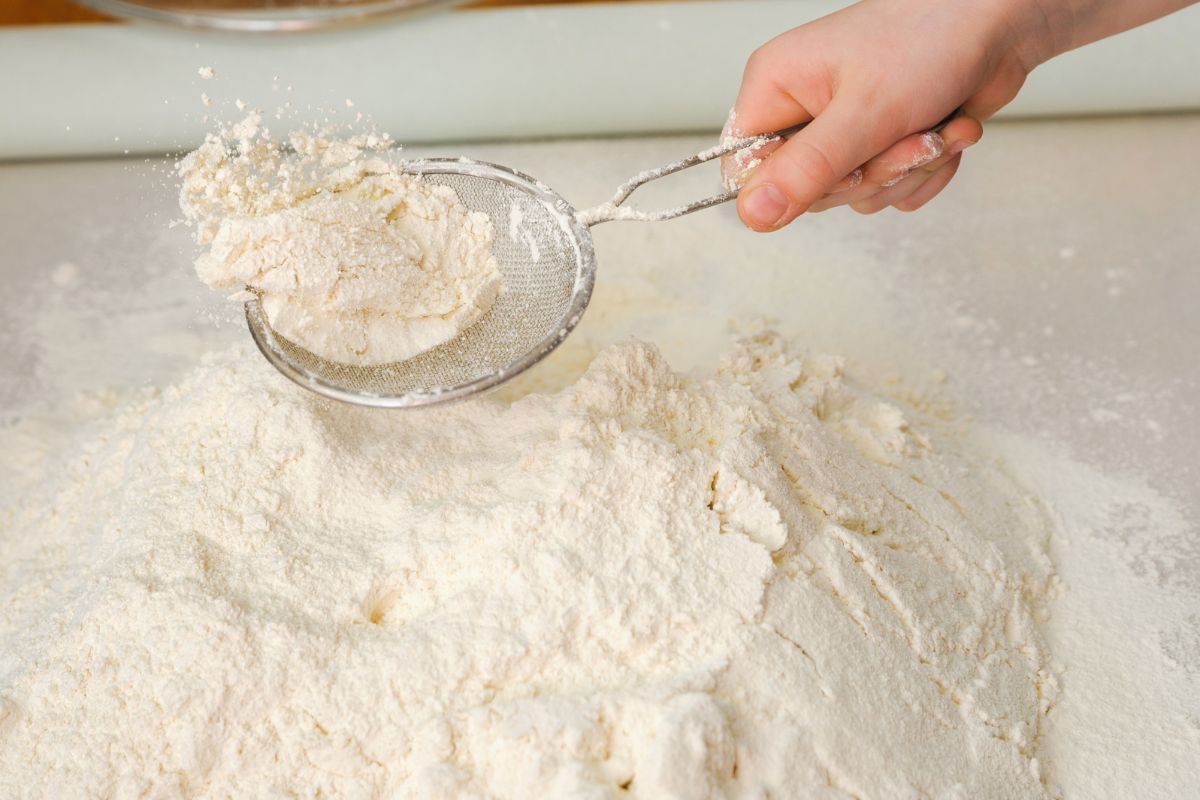We’ve all seen bakers and cooks sifting flour. It’s a scenic picture, normally found in every cookbook. But, when we look at the method or the instructions, they don’t always mention this step.
So, does that mean we don’t need to sift anything, or is it so expected that beginner books don’t bother to add in this step?
Below I’ve explained why sifting is important, along with other baking tips.
Why You Should Sift Flour
The purpose of sifting flour is to prevent clumps. The finer shape makes mixing easier, and you won’t be left with patches of pure flour in your bake.
The same can be said for any dry ingredients, such as cocoa powder and powdered sugar, but it affects flour the most due to its combining texture.
Sifting your flour for bread baking or cake baking will guarantee consistency in your creations.
Why Does My Bread Recipe Say To Sift The Flour?
The flour used to make bread needs sifting more than most other recipes. Your bread needs to be fluffy and light on the inside, but crusty over the top.
To get the balance right, you need to ensure your dough is even.
5 Practices To Avoid When Measuring Flour For Bread

When you’re baking, every measurement you make will directly affect the outcome of your creation.
Fulfilling an accurate measurement is the best way to create perfect rises, avoid lumps, and produce something worth showing off.
To help you out, here are some tips.
Don’t Be A “Flour Scooper”
Flour scoopers are people who use their measuring cups to scoop up their flour. It’s the simplest method to pick up your ingredients, but you don’t end up with an even load.
Depending on what you make, scooping might not matter. For example, brownies are a forgiving bake, but bread baking isn’t. One teaspoon over, and your bread will be too crumbly.
Instead, pour your flour into your measuring cup, and pour more than you need. Then use a sharp knife to scrape away the excess. With this method, you can make sure the flour is level and exact.
Don’t Use A Coffee Mug To Measure A Cup Of Flour
When your ingredients list tells you to measure a cup, they don’t mean just any old cup. Cup measurements are an official measuring unit.
You can find measuring cups in dollar stores and high-class bakery shops, so finding one won’t be hard.
Don’t Sift The Flour Before Measuring
If you sift the flour before measuring you’ll weigh the air pockets as well as the flour. Measure your flour first, and then start the sifting process so your weight is as accurate as possible.
Don’t Use Whatever Flour You Have Lying Around
When baking you should use the flour listed in your ingredient table. Using the wrong flour will make your bread denser or lighter than you intended.
If you’re making something less strict, you can swap your bread flour for all-purpose flour. The outcome won’t be as expected, but you should still end up with a good result.
How To Measure Sifted Flour
If you have already sifted your flour before you’ve measured it. The best thing to do is start again. However, on some occasions, this isn’t true.
If the recipe calls for “4 cups of flour, sifted”. This means you should measure unsifted flour and then sift it. But if it reads as “4 cups of sifted flour”, you need to sift the flour before measuring.
In this case, you should sift the flour right into a measuring cup, so you can see exactly how much flour you still need.
What If My Recipe Uses Cup Measurements, But I Want To Weigh My Flour?
If you don’t have a measuring cup, you can go by weight instead. 1 cup of flour will weigh 120 grams. Knowing this, you can weigh the number of grams you need until you reach the correct cup size.
If your cup measurements are 3 cups, then multiply 3 by 120 grams. That will get you 360 grams. Whatever the figure, multiply 120 by the number of cups.
A Better Way To Measure Flour For Bread

The best way to measure flour, apart from using measuring cups, is using a digital scale.
Digital scales are easier to read, as you don’t need to look at the device straight on to understand the exact measurement. They can also be converted automatically for you.
For example, if your recipe calls for cups, but you only have a scale, a digital scale might convert the weight into cups for you.
How To Sift Flour
Sifting flour is easy, all you need is a sifter and a bowl. Put your flour into the sifter, hover over the bowl, and with your free hand tap your palm against the sifter’s side.
This will shift the flour through the fine mesh strainer to create your fine ingredients.
Sifters are easy to find and cheap to buy, but if you don’t have a sifter you can still get fine results.
In this scenario, you should use a fork or a wire whisk and mix until the flour has become fine. The process isn’t as even as a flour sifter, but the amount of lumps you end up with will be minimal.
A fine mesh sieve would be better than a fork, but if you’re in desperate need then a fork or whisk can still do the job.
Final Thoughts
Next time someone asks you “Should you sift flour for bread”, you can confidently say “Yes”.
Wheat flour, white flour, whole wheat flour, or any other alternative you use should all be sieved. Sifting makes consistent results for your bread dough or any other baked goods.
Now create your delicious recipes, and have fun!










